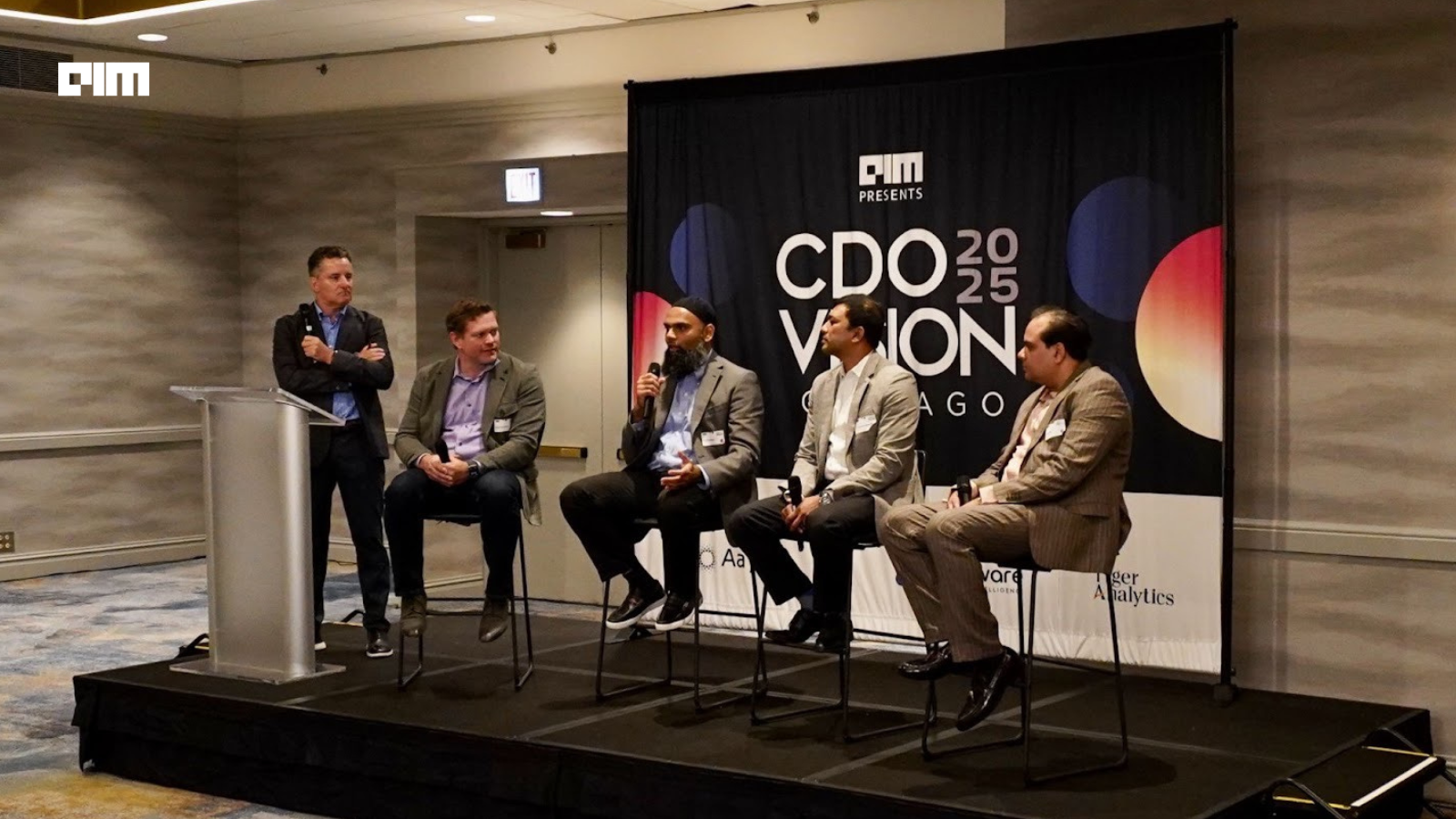The AI migration journey confronts organizations with an uncomfortable truth; while leadership debates strategy, employees are already feeding company data into public AI models to work faster. Meanwhile, legacy data systems crumble under new demands, and expensive pilots fail to move beyond proof-of-concept. Add regulatory pressures, governance gaps, and workforce fears, and the challenge becomes existential. Provide secure AI access in your enterprise without delay, understand that waiting for flawless data slows progress, and concentrate on use cases with quick payoffs. Winning requires viewing AI adoption as a cultural transformation, creating education programs, enabling business champions, and designing frameworks that foster safe experimentation.
The discussion featured insights from experienced Chief Data Officers and technology leaders navigating AI-first transformations across diverse industries. Anupam Pattanayak, Head of Enterprise Data Science and AI at Regions Bank. Vijay Jakka, Global Data Governance at MetLife. Sayeed Shariff, Sr. Director Data and AI at Hollister Inc. David Roberts, Chief Data Center Officer at MasTec and Sean Maccarthy, VP of Analytics at Good Sam
AI Strategy & Business Alignment
The foundation of effective AI implementation lies in targeting specific use cases that generate concrete returns rather than pursuing technology for novelty’s sake. Organizations are achieving results by enhancing revenue forecasting, streamlining customer interactions, and improving operational workflows. Success comes from concentrating efforts on proven applications that deliver clear benefits instead of scattered AI deployment across every business function.
Modern AI strategies represent fundamental business transformation rather than mere technology upgrades. This involves enabling predictive capabilities in decision-making processes, delivering hyper-personalized customer experiences, and establishing proactive engagement systems that operate in near-real-time. Cloud migration serves as the infrastructure foundation, while integration into core business operations,not siloed pilots,ensures sustainable impact.
Organizations benefit from pursuing parallel tracks: immediate wins alongside transformative initiatives. Enterprise tools like co-pilots provide quick value demonstrations that build organizational buy-in and momentum. Concurrently, advanced applications such as digital twins in manufacturing and R&D promise to compress development cycles that traditionally require extensive timeframes.
Prioritization follows value-based criteria, measuring projects against tangible business outcomes including accelerated response times, enhanced service delivery, and shortened production schedules. Practical implementations,internal chatbots, AI-enhanced SaaS platforms, and automated multilingual content generation,showcase immediate cost reductions and efficiency gains. Starting with low-risk, high-reward opportunities establishes credibility before pursuing larger initiatives. This measured approach emphasizes gradual scaling through continuous learning, avoiding the common failure pattern of premature enterprise-wide rollouts while maintaining focus on demonstrable business impact that justifies ongoing investment.
Governance and Data Security as Foundations
Enterprise data protection requires immediate action as employees actively use public AI tools to accelerate their work, potentially exposing sensitive company information to external models. Organizations must deploy enterprise editions of AI platforms immediately, centralizing usage through SSO-enabled versions while blocking non-approved instances to safeguard intellectual property and confidential data.
Effective governance demands transparent frameworks that provide visibility both internally and externally. In regulated environments, employees need clarity on AI usage policies while vendors and regulators require insight into adoption processes and compliance measures. Model governance for AI represents a broader challenge than traditional analytics oversight, requiring technical guidance and structured policies from implementation’s outset.
Controlled AI adoption enables innovation without compromising security. Enterprise tools allow safe exploration of capabilities across SaaS platforms, chatbots, and internal workflows. Even quick-win applications like AI-enabled service management tools or productivity assistants require governance oversight to prevent risk introduction during deployment.
Successful data and AI governance begins with centralized architecture where models and data remain accessible yet controlled. Starting with manageable, low-risk projects under strict policies allows organizations to learn and refine frameworks iteratively. Enterprise control isn’t optional,it’s the prerequisite for AI-first transformation. Governance implementation presents challenges, but delaying creates greater vulnerabilities as adoption accelerates regardless of organizational readiness.
Culture, Literacy & Employee Engagement
Organization-wide AI literacy forms the backbone of successful adoption. Comprehensive training programs, hands-on sessions, and dedicated learning initiatives ensure employees understand available tools, their capabilities, and proper usage protocols. Making AI education a required component of onboarding and ongoing development addresses knowledge gaps that leave workforces underprepared for AI-enabled environments.
Creating champions across functional areas accelerates adoption beyond IT departments. Business partners often become the most active AI users, demonstrating practical applications and inspiring peers through authentic advocacy. Hackathons provide structured engagement opportunities,training modules, certification processes, and team-based use case proposals generate enthusiasm while producing actionable implementations.
Cultural transformation requires accepting experimentation and learning from setbacks. Early projects focused on manageable, low-risk initiatives build infrastructure knowledge and organizational confidence. The “fail fast, learn fast” principle recognizes that technology and tools are purchasable, but embedding AI into organizational culture demands time and intentional development.
Visibility amplifies impact. Publicizing successes,tracked through productivity gains, cost savings, and efficiency metrics,inspires broader participation. When employees observe practical benefits in peer workflows, adoption naturally expands. Recognition of wins creates momentum, encouraging additional teams to engage. Ultimately, employee empowerment through education, championship programs, and transparent success-sharing establishes the cultural readiness necessary for sustained AI integration.
Implementation Through Iterative Processes
Successful AI implementation begins with low-risk, high-value projects that build organizational momentum and credibility. Quick wins include internal chatbots for knowledge retrieval, AI-enabled SaaS features within existing platforms, and specialized tools that dramatically reduce time and cost for specific tasks like multilingual content production.
Value-based adoption prioritizes projects with measurable impact, using pilot initiatives to learn, iterate, and scale gradually. When internal data quality poses challenges, leveraging public datasets,competitor information, industry websites, and external sources,provides viable pathways forward without waiting for perfect data infrastructure.
AI integration augments existing workflows rather than disrupting unprepared systems. Data platforms and virtualization enable efficient model access to relevant information, while ensuring projects remain scalable and replicable across departments. Technology and tools support success, but cultural readiness proves equally critical.
Measurement frameworks must reflect genuine usage and impact beyond superficial metrics. Tracking productivity improvements and operational outcomes, then publicizing results, creates organizational momentum and encourages broader adoption.
Governance embeds within process design from inception, ensuring pilots comply with enterprise policies and regulatory requirements. Centralized oversight prevents unmonitored usage, particularly in regulated sectors, while enabling safe scaling. This balanced approach,starting small, measuring rigorously, governing consistently,transforms experimental initiatives into sustainable enterprise capabilities.
Conclusion
Unmanaged AI adoption presents significant organizational risks as employees independently deploy public tools, potentially exposing sensitive data and intellectual property to external models. The gap between workforce AI usage and enterprise oversight creates vulnerabilities that governance frameworks must address immediately rather than reactively.
Success requires balancing innovation with control through measured, data-driven approaches. Organizations that implement enterprise-grade tools, establish transparent governance structures, and invest in workforce literacy position themselves to capture AI’s benefits while mitigating risks. Starting with manageable projects, tracking meaningful metrics, and scaling proven use cases builds sustainable capabilities rather than failed experiments.
The path forward demands recognizing that AI transformation extends beyond technology deployment,it requires cultural readiness, executive commitment, and structured processes. Companies that treat governance as foundational rather than restrictive, empower employees through education and champions, and maintain focus on measurable business value will navigate this rapidly evolving landscape successfully. The alternative,paralysis or reckless adoption,ensures obsolescence in an AI-driven competitive environment.











